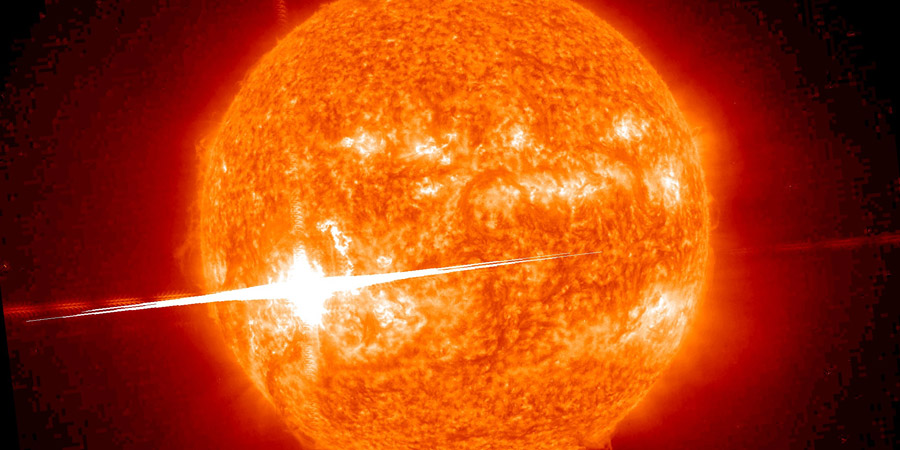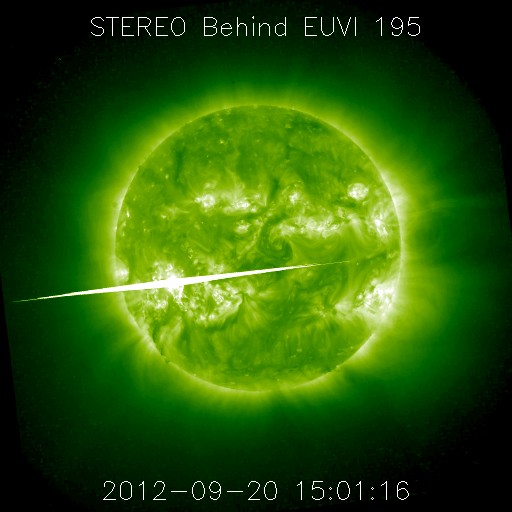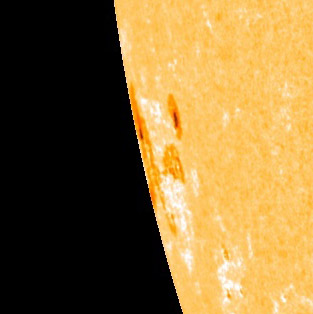Today two years ago: the strongest solar flare of this cycle?
Saturday, 20 September 2014 19:42 UTC

Number 35... the X1.6 solar flare that occured on September 10 was the 35th X-class solar flare of this solar cycle. It was a powerful solar flare but as far as X-class solar flares go... it was with a peak flux of X1.6 actually only a relatively modest solar flare when you consider that solar flares can get 10 or even 20 times stronger than that. The true X-treme solar flares are the so called ''super X-class solar flares''... X-class solar flares that peak at X10 or even higher. We have yet to see such a solar flare this cycle... or have we?
We say that the X1.6 solar flare from September 10, 2014 was the 35th X-class solar flare of this solar cycle but it is actually the 35th X-class solar flare of this solar cycle as seen from Earth. We do not know exactly how strong the solar flares are that occur at the far side of the Sun. We do have the STEREO Ahead and Behind spacecraft that watch the far side of the Sun but they do not have an instrument onboard like the GOES satellites have that measure the exact strength of a solar flare.
Scientists however have developed a method to estimate the strength of solar flares based on STEREO EUVI 195Å data. Based on correlation studies between the extreme UV (SDO, STEREO) and X-ray (GOES) fluxes, it has been estimated that the strongest solar flare so far this solar cycle likely occurred today exactly 2 years ago, on 20 September 2012. Based on STEREO's EUV data, the strength of that eruption was estimated to be between X5.8 and X18, with a peak flux of X12 being the most likely value. That would make it by far the strongest solar flare of the current solar cycle. The image below shows the solar flare as seen by STEREO Behind EUVI 195 back on 20 September 2012.
This amazing eruption took place at 15 degrees south and 153 degrees east from Earth's point of view which means the solar flare occured 63 degrees behind the east-limb. Despite the solar flare occuring well out of Earth's sight, the NASA SDO spacecraft could still see traces of the enormous blast in the Sun's corona. The video below shows the far side solar flare as seen by STEREO EUVI 195 and 304 followed by footage from SDO and the Coronal Mass Ejection as seen by SOHO/LASCO.
The question remains however... when will we see the first super X-class solar flare on the earth-facing solar disk? Anyone who wants to take a guess? Leave yours in the comments!
Credit: Soft X-ray Fluxes of Major Flares Far Behind the Limb as Estimated Using STEREO EUV Images. ESA/NASA SOHO. GSFC NASA. NASA SDO. LMSAL - Nariaki V. Nitta. NASA STEREO.
Solar activity
Back to today: solar activity remains low today with only an occasional C-class solar flare. There is a new sunspot region of decent size appearing on the east-limb but it is not clear yet if this region could produce a strong solar flare. It looks to be surrounded by faculae which could mean it is in decay. We will see more of this sunspot region in the coming days and we will be better able to see then if this sunspot region has some potential in it.
Geomagnetic conditions
A coronal hole high speed stream arrived yesterday and caused an isolated period of minor G1 geomagnetic storming. Those who follow us on Twitter were alerted by our system as this stream was not expected to arrive at Earth. Aurorae were nonetheless seen from many locations near the US-Canadian border. The solar wind speed remains elevated but the IMF conditions are not favourable for enhanced geomagnetic conditions at this time.
Thank you for reading this article! Did you have any trouble with the technical terms used in this article? Our help section is the place to be where you can find in-depth articles, a FAQ and a list with common abbreviations. Still puzzled? Just post on our forum where we will help you the best we can!
Latest news
Latest forum messages
Support SpaceWeatherLive.com!
A lot of people come to SpaceWeatherLive to follow the Sun's activity or if there is aurora to be seen, but with more traffic comes higher server costs. Consider a donation if you enjoy SpaceWeatherLive so we can keep the website online!

Space weather facts
| Last X-flare | 2025/03/28 | X1.1 |
| Last M-flare | 2025/04/22 | M1.3 |
| Last geomagnetic storm | 2025/04/21 | Kp5+ (G1) |
| Spotless days | |
|---|---|
| Last spotless day | 2022/06/08 |
| Monthly mean Sunspot Number | |
|---|---|
| March 2025 | 134.2 -20.4 |
| April 2025 | 126.2 -8 |
| Last 30 days | 125.9 -2.4 |


